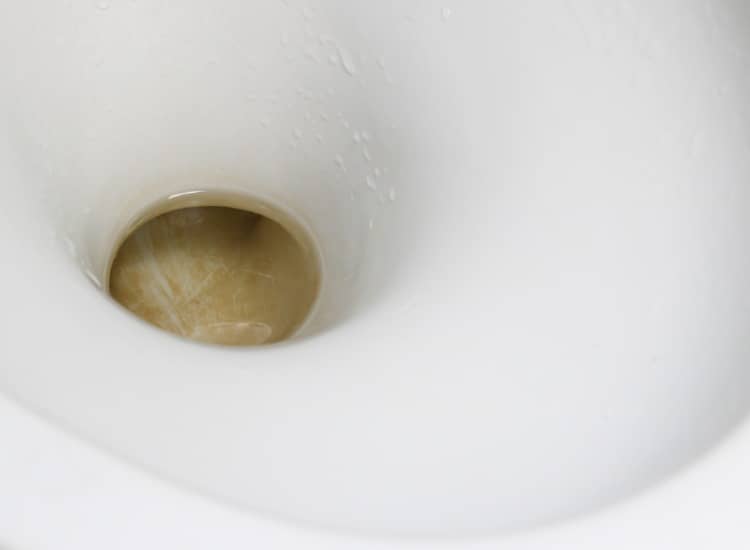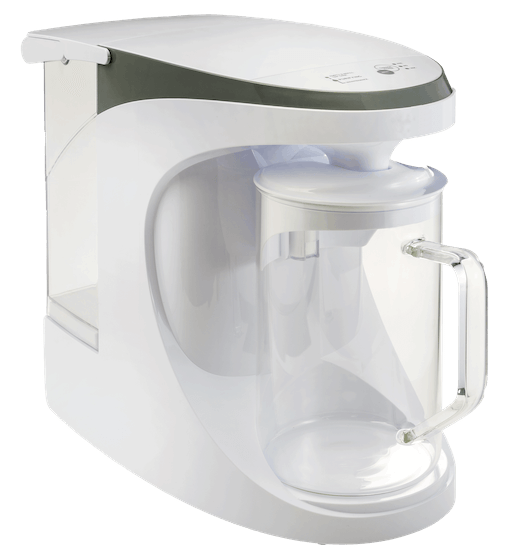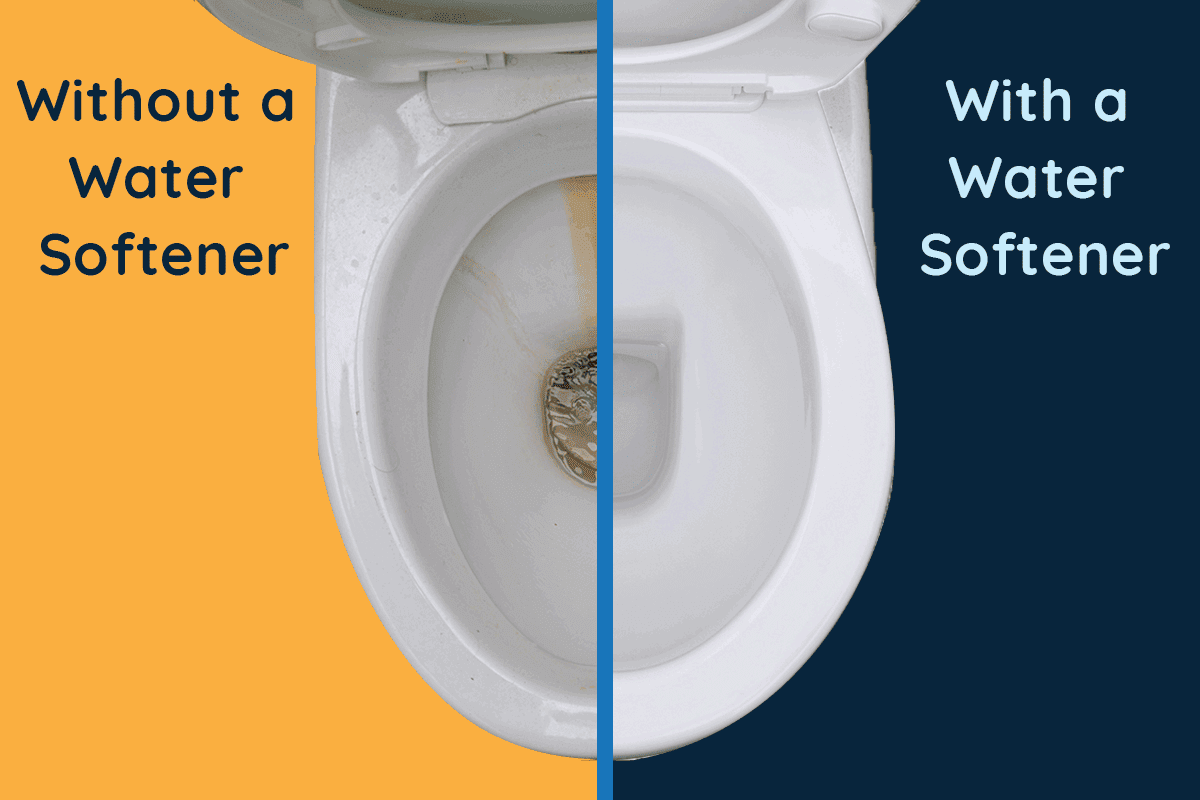How Water Softeners Prevent Brown Toilet Bowl Stains for Good
This blog features these key takeaways:
• Water with too much iron and manganese can cause brown toilet bowl stains.
• Cleaning these brown stains is a difficult and time-consuming process.
• Water softeners prevent brown stains through a process called ion exchange.
• A water test can help you find your ideal water softener.
• Whole house water filters and chlorine injection systems could also help with removing brown stains.

“It’s not what you think! I cleaned the toilet just today, honestly.”
How often have you wanted to say that when someone used your bathroom? It’s not a great feeling, is it?
We feel your pain.
Brown toilet bowl stains are one of the more embarrassing and frustrating problems you can have in your home. After all, it’s one thing to have a poopy toilet bowl. What’s worse is to have brown stains you can’t scrub away with regular bathroom cleaning supplies.
That seems like cruel and unusual punishment, and we’re here to help you right this wrong!
Instead of struggling to scrub these stains away, why not keep them from occurring in the first place? You can do this by fixing the root of the problem: your water.
This post will explain why hard water is likely causing those brown stains and how a water softener can prevent them from occurring. We will also help you clean any brown marks and explore some alternate solutions if a water softener isn’t right for you.
Of course, if you already know that you want a water softener, we can help you with that. Visit our water softener page below to learn more about the water softener services we provide.
For the rest of you, let’s jump in and learn how to make those brown stains history!

Follow Drew’s mission on YouTube
The Brown Stains are Actually Hard Water Stains
The first step to fixing a problem is identifying its source. Despite what you might think, these brown stains aren’t mysterious marks left by some cruel deity to torment you. In reality, they’re the natural byproduct of hard water, which contains high amounts of calcium, magnesium, iron and manganese.
There are two ways these minerals can infiltrate your water:
- Groundwater naturally collects them as it flows through the earth.
- Old iron pipes leach particles into the water as it flows to your home.
Either way, these elements make your water hard. And when that hard water slides down the porcelain bowl, the iron and manganese particles etch the sheen and stain the porcelain brown.
So, next time your guests accuse you of having unspeakable things in your bowl, you can drop some science on them by explaining it’s actually rust stains from iron and manganese.
Of course, you don’t want there to be a next time. So, let’s get to work getting those stains gone!
How to Get Brown Stains Out of Your Toilet
First, we’ll start by removing that unsightly brown toilet bowl stains from the bowl. As you may be aware, there are many methods for how to clean a stained toilet floating around the web. And trying to sort through all those methods is enough to give anyone a headache!
For this reason, we’ve tried to simplify the process for you by breaking it down into five best practices:
- Prep the toilet
- Use an acidic solution
- Give it time
- Scrub carefully
- Be persistent
Let’s take a closer look at what we mean by each of these items.
Step 1: Prep the Toilet
The first step to getting those brown blotches gone is proper preparation. You can accomplish this by doing the following:
- Turn off the main water valve on the back of the toilet.
- Remove all water from the bowl by fishing it out with a bucket or soaking it up with a sponge.
Removing the water is key because it will make room for adding the acidic cleaning solution next.
Step 2: Use an Acidic Solution
As we mentioned above, most regular bathroom cleaning liquids can’t remove brown stains. The reason for this is the liquids aren’t acidic enough. What you need is an acidic solution to cut through the iron and manganese stains and loosen them from the toilet.
Of course, we wouldn’t recommend using just any acidic solution for this job. The most effective acidic solution is muriatic acid, but this solution is far too dangerous for in-home use. It can burn skin and cause serious gastrointestinal problems if inhaled. So, we would strongly urge that you leave the use of muriatic acid to the professionals.
Instead, we recommend treating brown toilet bowl stains with any of the following acidic liquids that are safe for in-home use:
- Citric acid
- White vinegar
- Equal parts baking soda and vinegar
- A combination of vinegar, borax and salt
- Coca Cola
- Household cleaners containing diluted muriatic acid
- Acidic cleaners like Lime-A-Way and CLR
Any of these solutions, yes even Coca-Cola, should be able to break up the brown stains over time when poured into the bowl.
A couple of liquids that will NOT work are bleach and ammonia. Not only will these fail to remove the stains, but they can cause serious health problems if inhaled at high concentrations. So, we recommend sticking to any of the solutions in the list above.

Step 3: Give It Time
Here’s where getting rid of brown stains can be inconvenient and test your patience. Whatever acidic solution you use will need to sit in the bowl for at least half an hour to be effective. In fact, the longer you can leave the liquid in there to do its work, the better. For this reason, a great option is to add it to the toilet before bed and let it sit overnight.
Of course, this may not be realistic if you only have one toilet and may need to use it during that time. So, you will probably have to settle for a half-hour to an hour at most before moving on to scrubbing.
Step 4: Scrub Carefully
Once you’ve let the acidic cleaner sit for as long as you can, the next step is to scrub away at those brown stains. But don’t just grab any scrub brush and start scrubbing hard to vent your frustration. Scrubbing too hard can damage your toilet and make it so those stains are even harder to remove!
Instead, here are some pointers to follow for gentle scrubbing that should effectively remove the stains:
- Avoid using toilet brushes with wire bristles. Plastic or rubber bristles will be much gentler and more effective.
- You could also use a pumice stone. Just make sure you submerge it in water to soften it before you start scrubbing.
Once you’re done scrubbing, you can flush the toilet, and hopefully, the brown stains will completely flush away.
Step 5: Be Persistent
Unfortunately, brown toilet bowl stains don’t come off easily. So, your first try probably won’t get rid of them completely. Instead, you will likely have to repeat this process and maybe even try a few different acidic cleaners before your porcelain is white again. So, persistence is key.
But who wants to exert this type of effort every time they clean their toilet? Certainly not us! So, let’s look at how a water softener can ensure you won’t have to go through this annoying process again.


Stop Wasting Money!
Are you spending money every month on Bottled Water for your home or office? That adds up quickly and with inflation, it’s only going to cost more tomorrow.
With the NEW purAsure Counter top Reverse Osmosis System you never have to pay for another case of plastic bottles! Get yours before the price goes up and Enjoy cleaner, healthier water on demand!
Follow Drew’s mission on YouTube
How a Water Softener Can Eliminate Brown Toilet Stains
If you don’t care for the annoying process we described above, a water softener could be the solution you’re looking for. As we will see, many softeners can remove iron and manganese from the water. The key is finding the right water softener for your home’s needs and making it last.
We’ll look at how all of this works below.
How the Water Softeners Work
Salt-based water softener systems use a process called ion exchange to eliminate hard water minerals like calcium and magnesium from water. Many systems can also use this process to remove iron and manganese.
Here’s how the process works:
- Water containing iron and manganese enters the water softener tank, which contains many tiny resin beads.
- As the water flows through the beads, the iron and manganese ions attach to the beads and are replaced in the water with sodium ions.
- The newly softened water then flows into your home.
- Meanwhile, the beads remain in the system covered in iron and manganese until the softener uses a sodium solution to wash them clean in a process called regeneration.
With the iron and manganese gone, you will be able to enjoy fewer brown stains and easier toilet cleaning. It’s as simple as that.
The key is finding the right water softener for your needs to make this happen.
Finding the Right Water Softener
At Angel Water, we help homeowners identify their ideal softener every day. This process starts with a water test. Our licensed experts can test a home’s water to determine what contaminants are in it and the concentrations of each. So, to help you with your situation, we could find out how much iron and manganese are in your water.
Water softeners typically can handle a moderate amount of iron and manganese, usually a combined concentration of up to 5 mg/L. Some systems can handle more, others less. So, based on the results of your water test, we can determine which models will work best for you.
But you may be wondering what happens if you have more iron and manganese than a water softener could handle. The good news is there are other water treatment solutions that can handle greater concentrations. We will discuss these alternate options in detail below.
The test may also reveal that iron and manganese aren’t causing your brown stains. They could instead be caused by iron bacteria, manganese bacteria, or sulfur bacteria. Once again, there are also alternative solutions that can handle these contaminants, and we will look at them below as well.
For now, let’s look at an example of a water softener that may be the ideal solution for you.
Example Solution: The EcoWater ERC3700 Series
Some of the softeners we most frequently recommend to homeowners are the models in the EcoWater ERC3700 series.
EcoWater is one of the finest water softener manufacturers on the market with some of the most advanced systems available. And the softeners in its ERC3700 series are very effective at removing iron and manganese. In fact, they are certified to remove up to 15 ppm of iron.
Beyond this, these softeners can also remove harmful barium and radium 226/228 from the water and have some very convenient features like Wi-Fi and smartphone connectivity.
Please visit our water softener page to learn more about the systems we offer and how we can install them for you.

Keep the Brown Stains Gone with Water Softener Maintenance
One final thing we should mention is water softeners are great for removing brown stains, but they aren’t magic. You can’t just get a water softener and enjoy stain-free toilets forever without maintaining your system. In fact, if the system doesn’t receive the proper upkeep, you may start to notice those rust stains creep back into the bowl over time.
To keep this from happening, your system needs to get the regular maintenance recommended by the manufacturer. Most manufacturers stipulate that a system should get routine service at least once a year. The good news is a professional company like Angel Water can take this responsibility off your hands to fend off those brown stains.
Alternative Solutions for Brown Toilet Bowl Stains
As we mentioned above, if you have a high amount of iron and manganese in your water, a water softener may not cut it. A water softener also won’t help if you are dealing with other contaminants that cause brown stains, such as iron bacteria, manganese bacteria or sulfur bacteria.
Here are some alternative options for both of those instances:
Whole House Water Filters
Whole house water filters can protect against higher concentrations of iron and manganese. The right type of filter will depend on how many of these elements you’re dealing with. For example, an oxidizing filter can typically combat up to 15 mg/L and aeration/filtration should handle up to 25 mg/L.
Whatever concentration you’re dealing with, our team can help you find the right water filter to give you iron- and manganese-free water throughout your home!
Chlorine Injection System or Ozone Water Filter
If your home gets its water from a private well system, then there’s a good chance something more than iron and manganese is causing your toilet bowl stains. Well water frequently breeds a variety of bacteria, including iron bacteria, manganese bacteria and sulfur bacteria. These contaminants frequently leave slimy brown residue in toilets.
While water softeners can’t get rid of bacteria, other treatments solutions like chlorine injection systems and ozone water filters can.
A chlorine injection system uses chlorination to effectively kill the bacteria and keep them from staining your toilets. An ozone water filter does the same thing by charging oxygen to create ozone that attacks the contaminants.
Our team would be happy to help you determine if either of these options is best for your water.
Get Expert Assistance for Your Brown Toilet Bowl Stains
You don’t have to settle for embarrassing stains and a time-consuming cleaning routine anymore! A water softener system could be the solution that keeps those stains gone for good. And even if a water softener won’t help, alternative water treatment options exist as well.
Interested in finding your perfect solution? The first step is to get your water tested. At Angel Water, we provide water testing and a wide variety of water softeners, water filters and chlorine injection systems that could solve your problem!
Our team serves both Chicagoland and Southeast Florida. Please call us at 847-382-7800 or visit our water softener page to learn more.
Want Softer Water? Schedule an Appointment Now!
Find out how a water softener can help protect your home from hard water damage. Schedule an appointment with our water specialists today to explore the best solutions for your home.




